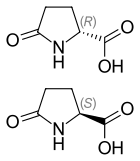Pyroglutamic acid

| |
| Names | |
|---|---|
| Preferred IUPAC name
5-Oxoproline | |
| Systematic IUPAC name
5-Oxopyrrolidine-2-carboxylic acid | |
Other names
| |
| Identifiers | |
3D model (JSmol)
|
|
| 3DMet | |
| Abbreviations | Glp |
| 82134 | |
| ChEBI |
|
| ChEMBL | |
| ChemSpider | |
| DrugBank | |
| ECHA InfoCard | 100.005.227 |
| EC Number |
|
| 1473408 | |
| KEGG | |
| MeSH | Pyrrolidonecarboxylic+acid |
PubChem CID
|
|
| RTECS number |
|
| UNII |
|
CompTox Dashboard (EPA)
|
|
| |
| |
| Properties | |
| C5H7NO3 | |
| Molar mass | 129.115 g·mol−1 |
| Melting point | 184 °C (363 °F; 457 K) |
| log P | -0.89 |
| Acidity (pKa) | -1.76, 3.48, 12.76 |
| Basicity (pKb) | 15.76, 10.52, 1.24 |
| Isoelectric point | 0.94 |
| Related compounds | |
Related compounds
|
proline 2-Pyrrolidone |
Except where otherwise noted, data are given for materials in their standard state (at 25 °C [77 °F], 100 kPa).
| |
Pyroglutamic acid (also known as PCA, 5-oxoproline, pidolic acid) is a ubiquitous but understudied natural amino acid derivative in which the free amino group of glutamic acid or glutamine cyclizes to form a lactam.[1] The names of pyroglutamic acid conjugate base, anion, salts, and esters are pyroglutamate, 5-oxoprolinate, or pidolate.

It is a metabolite in the glutathione cycle that is converted to glutamate by 5-oxoprolinase. Pyroglutamate is found in many proteins including bacteriorhodopsin. N-terminal glutamic acid and glutamine residues can spontaneously cyclize to become pyroglutamate, or enzymatically converted by glutaminyl cyclases.[2] This is one of several forms of blocked N-termini which present a problem for N-terminal sequencing using Edman chemistry, which requires a free primary amino group not present in pyroglutamic acid. The enzyme pyroglutamate aminopeptidase can restore a free N-terminus by cleaving off the pyroglutamate residue.[3]
Pyroglutamic acid exists as two distinct enantiomers:
- (2R) or D which happens to be (+) or d
- (2S) or L which happens to be (–) or l
Metabolism
[edit]As first discovered in 1882, pyroglutamic acid can be formed by heating glutamic acid at 180 °C, which results in the loss of a molecule of water. In living cells, it is derived from glutathione through the action of an enzyme, γ-glutamyl cyclotransferase.[1] Pyroglutamic acid may function in glutamate storage, and acts to oppose the action of glutamate, including in the brain.[1] It also acts on the brain's cholinergic system;[4] Amyloid β containing pyroglutamic acid is increased in Alzheimer's disease; this may be part of the disease process.[5] Increased levels of pyroglutamic acid in the blood, leading to excess in the urine (5-oxoprolinuria), can occur following paracetamol overdose, as well as in certain inborn errors of metabolism, causing high anion gap metabolic acidosis.[1][6]
Uses
[edit]The sodium salt of pyroglutamic acid—known either as sodium pyroglutamate, sodium PCA, or sodium pidolate—is used for dry skin and hair products, as it is a humectant. It has low toxicity and is not a skin irritant, but its use in products is limited by a high price.[7][8]
L-pyroglutamic acid is sold online as a nootropic dietary supplement.[9][10]
Magnesium pidolate, the magnesium salt of pyroglutamic acid, is found in some mineral supplements. In a preclinical study, additional pharmacological properties of pyroglutamic acid were revealed such as anti-phosphodiesterase type 5, anti-angiotensin-converting enzyme, and anti-urease activities.[11]
References
[edit]- ^ a b c d Kumar, Akhilesh; Bachhawat, Anand K. (2012). "Pyroglutamic acid: throwing light on a lightly studied metabolite" (PDF). Current Science. 102 (2): 288–297. JSTOR 24083854.
- ^ Schilling, Stephan; Wasternack, Claus; Demuth, Hans-Ulrich (1 August 2008). "Glutaminyl cyclases from animals and plants: a case of functionally convergent protein evolution". Biological Chemistry. 389 (8): 983–91. doi:10.1515/BC.2008.111. PMID 18979624. S2CID 24074284.
- ^ Podell, David N.; Abraham, George N. (March 1978). "A technique for the removal of pyroglutamic acid from the amino terminus of proteins using calf liver pyroglutamate amino peptidase". Biochemical and Biophysical Research Communications. 81 (1): 176–185. doi:10.1016/0006-291X(78)91646-7. PMID 26343.
- ^ Pepeu, Giancarlo; Spignoli, Giacomo (January 1989). "Nootropic drugs and brain cholinergic mechanisms". Progress in Neuro-Psychopharmacology and Biological Psychiatry. 13: S77–S88. doi:10.1016/0278-5846(89)90112-7. PMID 2694231. S2CID 11309268.
- ^ Jawhar, Sadim; Wirths, Oliver; Bayer, Thomas A. (11 November 2011). "Pyroglutamate Amyloid-β (Aβ): A Hatchet Man in Alzheimer Disease". Journal of Biological Chemistry. 286 (45): 38825–38832. doi:10.1074/jbc.R111.288308. PMC 3234707. PMID 21965666.
- ^ Liss, D. B.; Paden, M. S.; Schwarz, E. S.; Mullins, M. E. (11 October 2013). "What is the clinical significance of 5-oxoproline (pyroglutamic acid) in high anion gap metabolic acidosis following paracetamol (acetaminophen) exposure?". Clinical Toxicology. 51 (9): 817–827. doi:10.3109/15563650.2013.844822. PMID 24111553. S2CID 43541851.
- ^ "Hydromol® (Alliance)". British National Formulary. Retrieved December 5, 2015.
- ^ Jungermann, Eric; Sonntag, Norman O.V (1991-07-19). "Alternatives to Glycerine". In Eric Jungermann; Norman O.V. Sonnta (eds.). Glycerine: A Key Cosmetic Ingredient. CRC Press. p. 424. ISBN 978-0-8247-8465-2.
- ^ DellaVecchia, Matthew J. (December 2013). "Inaccurate Serelaxin Chemical Structure". Pharmacy and Therapeutics. 38 (12): 763. PMC 3875272. PMID 24391398.
- ^ McDougall, Graham J.; Austin-Wells, Vonnette; Zimmerman, Teena (24 June 2016). "Utility of Nutraceutical Products Marketed for Cognitive and Memory Enhancement". Journal of Holistic Nursing. 23 (4): 415–433. doi:10.1177/0898010105280097. PMC 2398696. PMID 16251490.
- ^ Šudomová, Miroslava; Hassan, Sherif T. S.; Khan, Haroon; Rasekhian, Mahsa; Nabavi, Seyed Mohammad (21 August 2019). "A Multi-Biochemical and In Silico Study on Anti-Enzymatic Actions of Pyroglutamic Acid against PDE-5, ACE, and Urease Using Various Analytical Techniques: Unexplored Pharmacological Properties and Cytotoxicity Evaluation". Biomolecules. 9 (9): 392. doi:10.3390/biom9090392. PMC 6770154. PMID 31438631.
